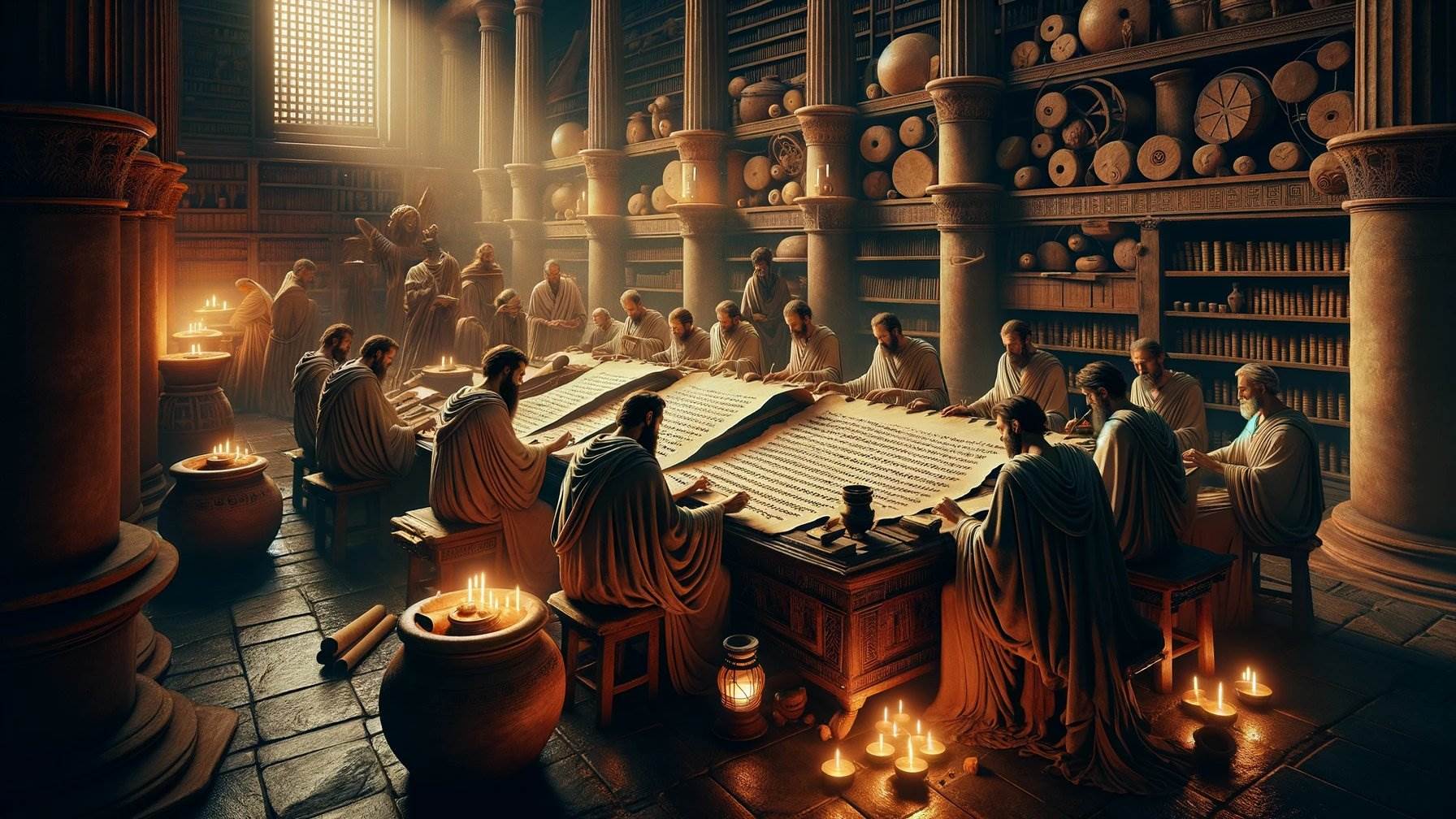Home>Arts and Culture>When Were The Homeric Hymns Written?


Arts and Culture
When Were The Homeric Hymns Written?
Published: March 7, 2024
Ericka Andersen, an editor at Christian.net, expertly merges digital strategy with content creation, focusing on faith and societal issues. Her communication skills enhance the platform's engaging narratives, fostering meaningful dialogue on belief's impact on society.
Discover the origins of the Homeric Hymns and their significance in arts and culture. Uncover the historical context and literary impact of these ancient Greek poems.
(Many of the links in this article redirect to a specific reviewed product. Your purchase of these products through affiliate links helps to generate commission for Christian.net, at no extra cost. Learn more)
Table of Contents
Introduction
When were the Homeric Hymns written? This question has puzzled scholars and enthusiasts of ancient literature for centuries. The Homeric Hymns are a collection of ancient Greek poems dedicated to various gods and goddesses, traditionally attributed to the legendary poet Homer. These hymns provide valuable insights into the religious beliefs and practices of the ancient Greeks. Exploring the origins and historical context of the Homeric Hymns can shed light on the time period in which they were composed and the cultural influences that shaped them. Let's delve into the fascinating world of ancient Greek literature and religious traditions to uncover the possible timeframe for the creation of these timeless hymns.
Read more: When Were The Gospels Written?
The Origins of the Homeric Hymns
The Homeric Hymns are a collection of 33 ancient Greek poems, each dedicated to a specific deity. These hymns were an integral part of religious rituals and were performed at festivals and other sacred occasions. The exact origins of the Homeric Hymns are shrouded in mystery, but they are believed to have been composed orally and transmitted through generations before being eventually transcribed. The hymns were likely a product of the rich oral tradition of ancient Greece, where poets and bards would recite and sing epic tales and hymns to honor the gods. The oral nature of their composition allowed for flexibility and variation, as different performers would add their own embellishments and interpretations, contributing to the diverse versions of the hymns that have survived to this day.
The Homeric Hymns are deeply rooted in the religious and cultural practices of ancient Greece. They served as a means of venerating the gods and goddesses, invoking their favor, and seeking their protection. The hymns also provided a form of entertainment and education, as they conveyed mythological narratives that were central to the Greek worldview. The themes of the hymns encompassed a wide range of topics, from the birth and deeds of the deities to the significance of specific religious rites and festivals. Through the Homeric Hymns, the ancient Greeks expressed their reverence for the divine and sought to understand the mysteries of the cosmos through storytelling and poetic expression.
The Homeric Hymns are characterized by their lyrical and evocative language, which reflects the poetic conventions of ancient Greek literature. The hymns exhibit a rhythmic and melodic quality that would have made them captivating when performed aloud. Their poetic structure and imagery contributed to their enduring appeal, ensuring that they remained a cherished part of Greek religious and literary tradition. The language of the hymns also reflects the cultural values and beliefs of the ancient Greeks, providing valuable insights into their worldview and spiritual outlook.
The Homeric Hymns were likely composed during a time when oral poetry held significant cultural and religious importance in ancient Greece. The tradition of oral composition and performance allowed for the continual reimagining and reinterpretation of the hymns, ensuring their relevance across different periods of Greek history. The origins of the Homeric Hymns can be traced back to the religious practices and artistic expressions of the ancient Greeks, where storytelling and poetic homage to the gods were integral to the fabric of society. The enduring legacy of the Homeric Hymns speaks to their enduring significance in the study of ancient Greek religion and literature.
The Language and Style of the Homeric Hymns
The language and style of the Homeric Hymns are integral to their enduring appeal and cultural significance. These ancient Greek poems are characterized by their lyrical and evocative language, which reflects the poetic conventions of the time. The hymns exhibit a rhythmic and melodic quality that would have made them captivating when performed aloud. Their poetic structure and imagery contributed to their enduring appeal, ensuring that they remained a cherished part of Greek religious and literary tradition.
The language of the Homeric Hymns reflects the cultural values and beliefs of the ancient Greeks, providing valuable insights into their worldview and spiritual outlook. The hymns are rich in metaphor and symbolism, employing vivid imagery to convey the stories and attributes of the gods and goddesses they celebrate. The use of vivid and descriptive language served to immerse the audience in the mythological narratives, evoking a sense of wonder and reverence for the divine beings they depicted.
The style of the Homeric Hymns is marked by its fluidity and expressiveness, allowing for the seamless interweaving of myth, ritual, and poetic artistry. The hymns demonstrate a mastery of storytelling, as they skillfully blend the divine and the mortal, the heroic and the everyday, creating a tapestry of narratives that resonate with both the spiritual and human dimensions of ancient Greek life. The rhythmic cadence and repetition in the language of the hymns would have made them well-suited for oral performance, enhancing their impact on the audience and reinforcing their role in religious and cultural expression.
The language and style of the Homeric Hymns reflect the artistic and religious sensibilities of the ancient Greeks, capturing the essence of their mythological imagination and spiritual devotion. Through their evocative language and masterful storytelling, the hymns continue to enchant and inspire readers and scholars, offering a window into the rich tapestry of ancient Greek literature and religious expression.
The Historical Context of the Homeric Hymns
The historical context of the Homeric Hymns is deeply intertwined with the religious, social, and cultural landscape of ancient Greece. These hymns emerged during a period of significant cultural and artistic flourishing, known as the Archaic period (c. 800-500 BCE). This era witnessed the rise of city-states, the development of trade networks, and the proliferation of artistic and literary achievements. The Homeric Hymns were composed against this backdrop of societal transformation, where the oral tradition of poetry and storytelling played a central role in shaping the collective identity of the Greek people.
The historical context of the Homeric Hymns also reflects the religious practices and beliefs of ancient Greece. The hymns were an integral part of religious rituals and festivals, serving as a means of honoring the gods and seeking their favor. The religious landscape of ancient Greece was characterized by a diverse pantheon of deities, each associated with specific domains and attributes. The Homeric Hymns provided a platform for expressing devotion to these gods and goddesses, reinforcing the interconnectedness of myth, ritual, and communal celebration within the religious life of the ancient Greeks.
Furthermore, the historical context of the Homeric Hymns is marked by the influence of oral tradition and poetic performance. In ancient Greece, poets and bards held esteemed positions within society, as they were the custodians of cultural memory and wisdom. The composition and recitation of epic poetry, including the Homeric Hymns, were central to the transmission of historical narratives, moral teachings, and religious lore. The oral performance of the hymns allowed for communal participation and engagement, fostering a sense of shared identity and spiritual kinship among the listeners.
The historical context of the Homeric Hymns also reflects the interconnectedness of Greek society with neighboring cultures and civilizations. The Mediterranean region was a nexus of trade, migration, and cultural exchange, leading to the cross-pollination of ideas, artistic motifs, and religious practices. The Homeric Hymns bear traces of this cultural interplay, incorporating elements that resonate with the broader religious and mythological traditions of the ancient Near East and beyond.
In essence, the historical context of the Homeric Hymns provides a window into the dynamic and multifaceted world of ancient Greece, where religious devotion, artistic expression, and communal identity converged to shape the cultural tapestry of the Mediterranean. The hymns stand as enduring testaments to the rich and complex heritage of the ancient Greeks, offering insights into the historical, religious, and artistic forces that shaped their worldview and collective imagination.
Theories on the Date of Composition
-
Oral Tradition and Early Development: One prevailing theory regarding the date of composition of the Homeric Hymns suggests that they originated during the early stages of Greek civilization, potentially as early as the 8th century BCE. This theory posits that the hymns were initially composed and transmitted orally, reflecting the oral tradition that characterized early Greek poetry. The fluidity and adaptability of oral composition allowed for the gradual development and refinement of the hymns over time, culminating in their eventual transcription and preservation.
-
Archaic Period and Cultural Flourishing: Another prominent theory situates the composition of the Homeric Hymns within the broader context of the Archaic period (c. 800-500 BCE), a time of significant cultural and artistic flourishing in ancient Greece. This theory aligns the creation of the hymns with the period's heightened literary and religious activities, where poets and performers played a central role in shaping the cultural identity of Greek society. The proliferation of city-states and the emergence of communal festivals provided fertile ground for the composition and dissemination of the hymns, contributing to their widespread popularity and influence.
-
Cultural Interactions and Syncretism: Some scholars propose that the composition of the Homeric Hymns may have been influenced by cultural interactions and syncretism, particularly with the religious traditions of the ancient Near East. This theory suggests that the hymns reflect a blending of indigenous Greek religious motifs with elements borrowed from neighboring cultures, resulting in a rich tapestry of mythological narratives and divine attributes. The cross-cultural exchanges that characterized the Mediterranean region during this period likely contributed to the diversity and complexity evident in the hymns.
-
Transition to Written Tradition: As the Greek world transitioned from oral to written modes of expression, the composition of the Homeric Hymns may have evolved to accommodate this shift. The emergence of writing and the establishment of literary traditions provided new avenues for the preservation and dissemination of the hymns, marking a pivotal moment in their historical development. The transition to a written tradition allowed for greater standardization and textual stability, ensuring the enduring legacy of the hymns for future generations.
-
Continual Adaptation and Reinterpretation: A compelling perspective on the date of composition emphasizes the continual adaptation and reinterpretation of the Homeric Hymns across different historical periods. This theory underscores the dynamic nature of the hymns, which underwent modifications and embellishments as they were performed and transmitted by various poets and performers. The fluidity of their composition allowed for ongoing reimaginings, ensuring their relevance and resonance in the ever-evolving landscape of ancient Greek culture and religious expression.
The diverse theories on the date of composition of the Homeric Hymns reflect the complex interplay of historical, cultural, and artistic forces that shaped their creation and transmission. While the precise timeframe of their composition remains a subject of scholarly debate, these theories offer valuable insights into the rich tapestry of ancient Greek literature and religious tradition.
Read more: Dates When The Gospels Were Written
Conclusion
The Homeric Hymns, with their origins rooted in the rich oral tradition of ancient Greece, stand as timeless expressions of religious devotion, artistic mastery, and cultural identity. The lyrical language and evocative style of the hymns reflect the poetic conventions of the time, captivating audiences and preserving the mythological narratives of the Greek pantheon. Situated within the historical context of the Archaic period, the hymns emerged as integral components of religious rituals and communal celebrations, embodying the interconnectedness of oral poetry, religious expression, and cultural flourishing. The diverse theories on the date of composition offer valuable perspectives on the historical development and transmission of the hymns, shedding light on the dynamic and multifaceted forces that shaped their creation. As enduring testaments to the enduring legacy of ancient Greek literature and religious tradition, the Homeric Hymns continue to inspire and enchant readers, inviting them to immerse themselves in the timeless world of myth, ritual, and poetic artistry.














